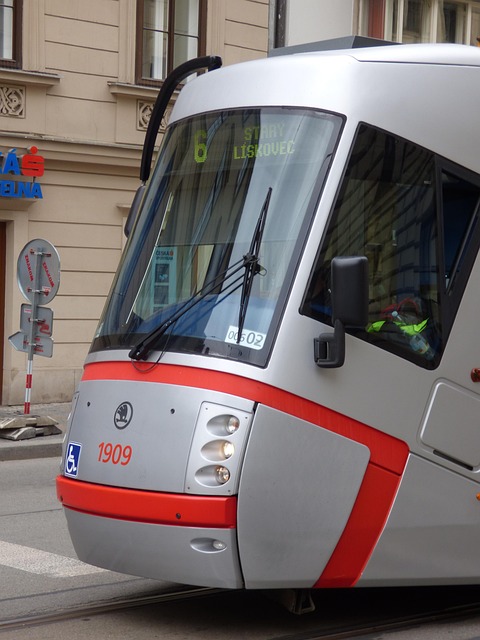Vehicle-to-Vehicle (V2V) communication revolutionizes urban mobility by enabling direct vehicle data exchange, enhancing safety and traffic flow through real-time sharing of speed, direction, and hazards. This technology is crucial for efficient smart city solutions, but interoperability challenges among diverse vehicle models require standardization. Cost-effective V2V solutions hold potential for accident reduction, traffic optimization, and environmental mitigation, fostering intelligent transportation systems (ITS) development.
“Explore the transformative potential of Vehicle-to-Vehicle (V2V) communication technology in paving the way for safer roads and smarter cities. This advanced system enables vehicles to exchange data, revolutionizing traffic management and enhancing overall urban mobility. In this article, we delve into the intricacies of V2V tech, uncover its numerous benefits for smart city initiatives, and examine the challenges and future prospects of its implementation. By harnessing the power of select V2V communication, cities can navigate towards a safer and more efficient transportation network.”
- Understanding Vehicle-to-Vehicle Communication Technology
- Benefits of V2V for Smart City Traffic Management
- Challenges and Future Prospects of Implementing V2V
Understanding Vehicle-to-Vehicle Communication Technology

Vehicle-to-Vehicle (V2V) communication technology is revolutionizing road safety and urban mobility. By enabling direct vehicle-to-vehicle data exchange, V2V systems create a smart grid integration within the transportation network. This technology goes beyond traditional vehicle-to-infrastructure (V2I) communication, allowing cars to communicate with each other in real-time, regardless of their location or the presence of roadside infrastructure. Each vehicle becomes a node in a dynamic ad-hoc network, sharing crucial information about speed, direction, and braking patterns.
This innovative approach plays a pivotal role in enhancing autonomous driving capabilities. V2V for autonomous driving enables vehicles to coordinate and respond to each other’s actions, improving overall traffic flow and safety. By leveraging vehicle ad-hoc networks, smart cities can implement urban mobility solutions that are more efficient, responsive, and resilient. Through seamless communication, V2V technology paves the way for a future where roads are safer and cities are more livable.
Benefits of V2V for Smart City Traffic Management

The integration of Vehicle-to-Vehicle (V2V) Communication technology in smart cities offers a transformative approach to traffic management, enhancing road safety and efficiency. By enabling direct vehicle-to-vehicle communication, V2V systems create an intelligent network on the roads, allowing vehicles to exchange real-time data such as location, speed, and impending hazards. This interconnectedness empowers cities to implement sophisticated traffic control strategies, optimizing flow and reducing congestion.
One of the key advantages is the potential for cost-effective V2V solutions, where the collective intelligence of a network of vehicles can significantly reduce the burden on traditional infrastructure. Moreover, integrated mobility systems become more feasible, enabling seamless travel experiences with improved public transportation coordination. However, as the technology advances, addressing data privacy concerns related to long-range vehicle communication is essential to gaining public trust and ensuring secure V2V interactions within smart cities.
Challenges and Future Prospects of Implementing V2V

Implementing Vehicle-to-Vehicle (V2V) communication technology presents a promising path toward safer roads and smarter cities, revolutionizing the way vehicles interact and enhancing overall transportation efficiency. However, several challenges must be addressed to fully unlock its potential. One of the primary hurdles is ensuring interoperability between diverse vehicle models and communication protocols, as the automotive industry lacks uniform standards. Standardization efforts are crucial to enabling seamless V2V interactions across different manufacturers’ fleets.
Looking ahead, the future of connected cars holds immense potential for reducing accidents, optimizing traffic flow, and mitigating the environmental impact of V2V technology. Cost-effective V2V solutions that balance performance with affordability are essential to encourage widespread adoption, fostering the development of intelligent transportation systems (ITS). By seamlessly integrating V2V into existing infrastructure, cities can create more responsive, efficient, and sustainable urban mobility ecosystems.
Vehicle-to-Vehicle (V2V) communication technology holds immense potential in transforming urban mobility, making roads safer and smarter. By enabling direct vehicle-to-vehicle exchange of data, V2V can significantly enhance traffic management in smart cities. While challenges such as privacy concerns and standardization remain, ongoing research and development efforts promise a future where V2V becomes a cornerstone of efficient and secure transportation systems. As we select and implement this cutting-edge technology, we take a step closer to navigating smarter, safer cities.
